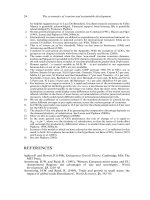THE ECONOMICS OF MONEY,BANKING, AND FINANCIAL MARKETS 376
Bạn đang xem bản rút gọn của tài liệu. Xem và tải ngay bản đầy đủ của tài liệu tại đây (39.81 KB, 1 trang )
344
PA R T I V
The Management of Financial Institutions
QUESTIONS
You will find the answers to the questions marked with
an asterisk in the Textbook Resources section of your
MyEconLab.
1. Why might a bank be willing to borrow funds from
the Bank of Canada at a higher rate than it can borrow from other banks?
*2. Rank the following bank assets from most to least
liquid:
a. Commercial loans
b. Securities
c. Reserves
d. Physical capital
3. Why has the development of overnight loan markets made it more likely that banks will hold fewer
reserves?
*4. If the bank you own has no excess reserves and a
sound customer comes in asking for a loan, should
you automatically turn the customer down, explaining that you don t have any excess reserves to lend
out? Why or why not? What options are available for
you to provide the funds your customer needs?
5. If a bank finds that its ROE is too low because it has
too much bank capital, what can it do to raise its
ROE ?
*6. If a bank is falling short of meeting its capital requirements by $1 million, what three things can it do to rectify the situation?
7. If a bank doubles the amount of its capital and ROA
stays constant, what will happen to ROE ?
*8. What does the net interest margin measure, and
why is it important to bank managers?
9. Which components of operating expenses experience
the greatest fluctuations? Why?
10. Can a financial institution keep borrowers from
engaging in risky activities if there are no restrictive
covenants written into the loan agreement?
*11. Why are secured loans an important method of
lending for financial institutions?
12. If more customers want to borrow funds at the prevailing interest rate, a financial institution can
increase its profits by raising interest rates on its
loans. Is this statement true, false, or uncertain?
Explain your answer.
*13. Why is being nosy a desirable trait for a banker?
14. A bank almost always insists that the firms it lends
to keep compensating balances at the bank. Why?
*15. Because diversification is a desirable strategy for
avoiding risk, it never makes sense for a financial
institution to specialize in making specific types of
loans. Is this statement true, false, or uncertain?
Explain your answer.
Q U A N T I TAT I V E P R O B L E M S
1. Using the T-accounts of the First Bank and the
Second Bank, describe what happens when Jane
Brown writes a $50 cheque on her account at the
First Bank to pay her friend Joe Green, who in turn
deposits the cheque in his account at the Second
Bank.
*2. What happens to reserves at the First Bank if one
person withdraws $1000 of cash and another person
deposits $500 of cash? Use T-accounts to explain
your answer.
3. The bank you own has the following balance sheet:
Assets
Reserves $ 75 million
Loans
$525 million
Liabilities
Deposits
$500 million
Bank capital $100 million
If the bank suffers a deposit outflow of $50 million
and has a desired reserve ratio on deposits of 10%,
what actions must you take to keep your bank from
failing?
*4. If a deposit outflow of $50 million occurs, which
balance sheet would a bank rather have initially, the
balance sheet in Problem 3 or the following balance
sheet? Why?
Assets
Reserves $100 million
Loans
$500 million
Liabilities
Deposits
$500 million
Bank capital $100 million
For Problems 5 9, assume that the First Bank initially has
the balance sheet shown on page 334. Also assume that
the average duration of its assets is three years, that of its
liabilities is two years, that interest rates are initially at
10%, and that the bank s equity capital is $10 million.
5. If the First Bank sells $10 million of its fixed-rate
assets and replaces them with rate-sensitive assets,
what is the income gap for the bank? What will happen to profits next year if interest rates fall by 3 percentage points?









